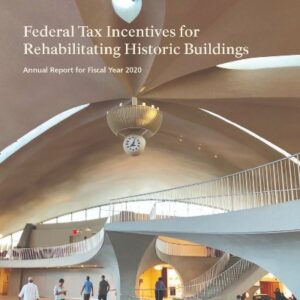The National Park Service recently released their Federal Tax Incentives for Rehabilitating Historic Buildings Annual Report for FY 2020, and it shows that despite the unprecedented year, the federal historic tax credit was able to have a positive impact for historic communities across Maryland and around the country.
POSITIVE ECONOMIC IMPACT
 In 2020, the Park Service certified 989 historic rehabilitation projects nationally, which totaled $6.54 billion in estimated rehabilitation costs. These projects ranged from large catalytic rehabilitation projects to smaller local projects. In fact, the report shows that in 2020, almost half of all projects completed had total expenditures of under $1 million QRE, with 19% under $250,000. In Maryland, the impact of the program is impressive. The National Park Service approved 100 HTC applications in 2020, and completed Federal HTC projects resulted in $201.5 million in rehabilitation costs. Even during a pandemic, historic preservation projects are local economic drivers
In 2020, the Park Service certified 989 historic rehabilitation projects nationally, which totaled $6.54 billion in estimated rehabilitation costs. These projects ranged from large catalytic rehabilitation projects to smaller local projects. In fact, the report shows that in 2020, almost half of all projects completed had total expenditures of under $1 million QRE, with 19% under $250,000. In Maryland, the impact of the program is impressive. The National Park Service approved 100 HTC applications in 2020, and completed Federal HTC projects resulted in $201.5 million in rehabilitation costs. Even during a pandemic, historic preservation projects are local economic drivers
PROGRAM Background
Owners of historic buildings who complete rehabilitation and adaptive reuse projects to the Secretary of the Interior Standards may apply for a 20% income tax credit on qualified project expenditures. The HTC program encourages private investment in historic preservation projects and it also returns more to the Treasury than it costs. In fact, the credit returns about $1.20 in tax revenue for every dollar invested, and since its inception, the federal HTC has generated more than $28 billion in federal tax revenue through its investment in historic preservation. Over the last 44 years, the credit has leveraged $109.18 billion in investment and rehabilitated more than 46,372 buildings—all while generating enough in federal revenue to pay for itself. Since 2001, in Maryland this credit has made possible over $1.5 billion in rehabilitation projects in nearly every county.
The adaptive resuse of St. Michael’s Church in Baltimore, Maryland into the Ministry of Brewing was included in the national report:
Increasing the economic impact in maryland
Financing an historic preservation project often takes a complex matrix of funding that may include federal, state, and local tax credits. A strong, well-funded state historic tax credit would help increase the positive economic impact of the federal credit. Preservation Maryland actively advocates for increased funding and policy changes that will strengthen the efficacy of the Maryland Historic Revitalization Tax Credit so that even more buildings take advantage of this economic driver.
